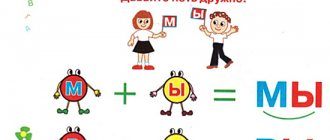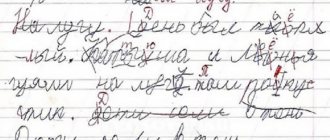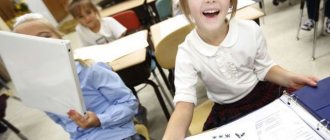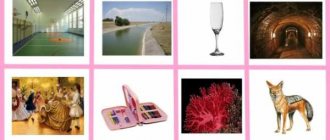4.5
Average rating: 4.5
Total ratings received: 22.
4.5
Average rating: 4.5
Total ratings received: 22.
All words in Russian consist of syllables. A syllable is the sounds of a word pronounced with one impulse of air. A syllable can consist of one vowel sound or a vowel and several consonants, and be open or closed. If a word has two syllables, then it is a disyllabic word. Let's remember what syllables are and how to understand how many syllables there are in a word.
Syllables
In one syllable there is a mandatory vowel sound, next to which there is one or more consonants: vo-da, pine-na. A syllable can only consist of a vowel sound: o-na.
How to understand how many syllables are in a word? Bring your straight palm to your chin from below, touching it lightly. Say the word clearly. The number of times the palm touches the collections, the number of syllables in the word.
There are two types of syllables:
- open;
- closed.
Open syllable
Open syllables ending in a vowel sound are formed in two ways. Any syllable consists of a vowel sound, because it is precisely this sound that is formed by the voice, so a syllable can be formed by a single vowel sound: e-ko-log, a-rest.
The second type of open syllable is when a consonant is followed by a vowel: ru-ka, vol-lya.
You can pronounce an open syllable for a long time and sing it.
Closed syllable
Closed syllables are those that end with a consonant sound: art-tist, pok-rov.
A word can consist of only open syllables or closed ones, or they can be both.
- Only open syllables: pa-na-ma, hat-pa.
- Only closed syllables: approach, dawn.
- Mixed syllables: ko-tel, kar-ti-na.
Every year the number of children suffering from TSD increases. Most of them have, to one degree or another, a violation of the syllabic structure of the word (SWS). In speech therapy work with children, overcoming shortcomings in sound pronunciation is often highlighted and the importance of the development of the cardiovascular system is underestimated. Difficulties in pronouncing individual sounds, as well as focusing on overcoming them, lead to the fact that the sound, and not the syllable, becomes the unit of pronunciation. This is somewhat contrary to the natural process of speech development. Therefore, it is of particular importance to determine the correct relationship between the development of sound pronunciation and mastery of the syllabic structure of a word. Correction of the cardiovascular system is one of the priority tasks in speech therapy work with preschoolers with systemic speech disorders. The formation of the CVS affects the success of mastering the grammatical structure of speech, mastering sound analysis, writing, and reading.
Since this topic has not been sufficiently studied and covered in educational and methodological literature, speech therapists experience difficulties in organizing work on the formation of the syllabic structure of a word: in systematizing and selecting speech didactic material, providing classes with lexical richness.
This manual presents a system of working on the syllabic structure of a word, based on an analysis of the literature on this problem and on personal teaching experience.
Types of violations of the syllabic structure of words
A.K. Markova identifies the following types of violations of the syllabic structure of a word:
1. Violation of the number of syllables:
- Abbreviation (omission) of a syllable: “skein” - hammer;
- Omission of the syllabic vowel: “pinino” - piano;
- Increasing the number of syllables by inserting vowels into consonant clusters: “komanata” - room;
2. Violation of the sequence of syllables in a word:
- Rearrangement of syllables: “devore” - tree;
- Rearrangement of sounds of adjacent syllables: “hebemot” - hippopotamus;
3. Distortion of the structure of an individual syllable:
- Abbreviation of consonant clusters: “tul” - chair;
- Insertion of consonants into a syllable: “limont” - lemon;
4. Similarity of syllables : “coconuts” - apricots;
5. Perseverations (cyclical repetition of one syllable).
6. Anticipations (replacing previous sounds with subsequent ones): “nananas” - pineapples;
7. Contaminations (mixing elements of words): “booth” - kennel + booth.
Stages of working on the syllabic structure of a word
For the formation of the syllabic structure of a word, such non-speech processes as optical-spatial orientation, the possibility of tempo-rhythmic organization of movements and actions, and the ability to serially process information are significant. These non-speech processes are the basic prerequisites for the acquisition of the syllabic structure of a word.
Corrective work to overcome CVS disorders can be divided into 2 stages:
- preparatory, the purpose of which is to prepare the child to master the rhythmic structure of words in his native language; work is carried out on non-verbal and verbal material;
- proper correctional, the purpose of which is the direct correction of cardiovascular system defects in a particular child; work is carried out on verbal material.
Preparatory stage
The preparatory stage includes work in the following areas:
- formation of spatial concepts and optical-spatial orientation;
- development of temporal-spatial orientation;
- development of dynamic and tempo-rhythmic organization of movements.
Below are sample games and exercises to develop these functions. At the preparatory stage, these games and exercises can be used simultaneously, that is, all areas of work can be included in one lesson. Exercises are used not only in speech therapy classes, but also in classes on the development of elementary mathematical concepts, in music classes, in drawing, physical education, and in classes to familiarize themselves with the outside world.
I. Formation of spatial representations and optical-spatial orientation
1. Orientation in your own body
- “This is what we are like” (“Show your belly, your back”: The belly is in front, the back is behind. Where is the tummy? Where is the back?).
- “Getting things in order” (in front of the child there are mittens, gloves, sandals, etc. - “Find a pair”, “Place the sandals correctly”).
- “Palms and footprints” (The child is offered the outlines of several palms and footprints and the outline of a palm for which he must find a pair from the proposed options).
2. Orientation in three-dimensional space
- “Train” (Toys are placed in a column in front of the child and questions are asked: “Who is in front? Who is behind? Who is far away? Who is close?”)
- “Assemble a fairy tale” (In front of the child is a set of toys or objects: “Place the horse close to the house. Place the little man between the house and the tree.”)
- “Find the treasure” (orientation using diagrams).
- “Where the locomotive is humming” (determining the location of the sound).
II. Development of temporal-spatial orientation
- “The bunny went to visit” (The child in the role of a bunny goes, according to instructions, to visit a squirrel, a hedgehog, a frog. Who had it first, then, at the very end?)
- “What first, what then” (The adult gives the child tasks: 1) first jump, then squat, at the end clap your hands; 2) first rock the bear, then feed the bunny, at the end dress up the doll - the child performs and then describes the sequence of his actions).
- “Look and repeat” (The adult shows a series of movements, the child watches, then repeats all the movements in the desired sequence)
III. Development of dynamic and tempo-rhythmic organization of movements
Areas of work:
- Improving gross motor movements
- Improving fine motor skills
- Development of articulatory motor skills
- Developing a sense of tempo
- Formation of a sense of rhythm
Improving motor skills: general, fine, articulatory
Goal: development of spatial organization of movements; development of switchability of movements; development of the ability to reproduce a given sequence of movements.
- "Do as I do"
The speech therapist performs a series of first two, then three or four movements, the children follow the instructions: “Do as I do”, “Continue yourself”: 1) Sit down - stand up, sit down - stand up, ... 2) Hands to the sides - on the belt, in sides - on the belt, ...3) Leg forward - back - to the side, forward - back - to the side.
- "Skillful Hands"
Alternation of different poses: 1) Fists - palms, ... 2) Rings - ears - horns, ... 3) Fingers say hello.
- Articulation exercises
Alternation of different poses of the organs of the articulatory apparatus: 1) “Frog” - “Proboscis” - “Donut”; 2) “Watch”; 3) “Spatula” - “Needle”.
Developing a sense of tempo
Goal: to teach to distinguish, reproduce, characterize tempo based on tactile-kinesthetic, visual, and auditory sensations.
- "Mouse and Cat"
An adult shows the children how easily and quickly a mouse runs on its toes, and a cat slowly sneaks behind it. The movements are performed in a circle to the sound of a tambourine. For frequent blows - quickly, like a mouse, for rare blows - slowly, calmly, like a cat.
- "Fists - palms"
An adult reads a poem, and children perform hand movements at the right pace:
Anyone has two fists, one knocks lightly on the other: Knock - knock, knock - knock. Well, the palms don’t lag behind, they beat them cheerfully: Clap - clap, clap - clap. The fists beat faster, how hard they try: Knock - knock - knock, knock - knock - knock, And the palms are just there, scattering: Clap - clap - clap, clap - clap - clap.
Formation of a sense of rhythm
Goals: to teach to perceive metric relationships (accented unaccented beats are a prerequisite for mastering stress), to distinguish and reproduce rhythm based on tactile-kinesthetic, visual, and auditory sensations.
- “Thunder” (clap your hands loudly, or quietly, leaning on the drawing - a large cloud - a loud clap, a small cloud - a quiet one).
- Graphic switching exercises: “Beads” (alternating beads of different colors - for example, red - yellow - red - yellow, etc.), “Path” (alternating two or three geometric shapes, various objects).
- Reproduction of rhythms based on clarity, on patterns: “Snowflakes”, “Rain”, “Woodpecker” (“Rain” - a large drop - a long clap, a small drop - a short one).
- Reproduction of a given ri
The adult has wooden spoons in his hands, the children stand in a circle. An adult walks around the circle and sings: Gray Little Bunny has come to visit. The little gray bunny found a spoon. I found the spoons and went up to the house. He stops behind the child and knocks on the spoons: knock - knock - knock. The child asks: “Who’s there?” The adult replies: “It’s me, Bunny, and who are you?” The child answers: “….” The adult continues: “Come on... come out and knock on the spoons with me!” The adult plays the child on the spoons with any of the proposed rhythms: / //; // /; // //; / // / etc.
Corrective stage
Corrective work is carried out on verbal material and consists of several levels. The transition to the next level occurs after mastering the material of the previous level.
The following levels are distinguished:
- level of vowel sounds;
- syllable level;
- word level;
- level of short sentences;
- level of pure proverbs, poems and other texts.
Particular importance at each level is given to “inclusion in work” in addition to the speech analyzer, also the auditory, visual and tactile ones. Below are suggested exercises for each level.
Working on vowels
- Pronouncing a series of two, three or more sounds:
- accompanied by symbols (“Men - sounds”)
- without visual support.
- Pronunciation of a number of vowels with emphasis on one of them (also - with support for clarity and without it - by ear).
- Recognition and pronunciation of a series of vowels from the silent articulation of an adult.
- "Musical Ball"
An adult, throwing a ball to a child, makes one or two (at the next stage more) sounds. The child repeats and returns the ball.
- Pronouncing a series of vowels, changing the volume, tempo, “mood” (sad, angry, affectionate) of the voice.
- Pronounce as many vowels as there are flowers in the meadow.
- Stand up when a series of two (or other specified number) sounds sounds.
Working on syllables
Work is carried out with different types of syllables:
- with a common consonant (for example, the exercise “Rolling a snow woman” - imitating the movements, pronounce: ba - bo - bu - would);
- with a common vowel (ka - ta - ma - va);
- reverse syllables (Say “Aw - aw” as many times as there are dots);
- closed syllables, their rows and pairs (various onomatopoeias);
- direct and reverse syllables with oppositional sounds: according to hardness - softness, sonority - deafness (“We hammer in nails with a hammer: ta - yes - ta - yes, then - to - to - to");
- syllables with confluence.
Techniques and exercises:
- “Musical ball” (see “Working on vowels”)
- The combination of pronouncing syllabic rows with any rhythmic movement: with drawing or tracing broken lines; with laying out sticks and circles; with drawing patterns with a finger in cereals poured into a small box.
- Working with rhythmic patterns (Exercise “Chicken”: the child is offered a rhythmic pattern // / // / /// / /, he needs to voice it: ko-ko ko ko-ko ko ko-ko-ko ko ko).
Working on the word
A.K. Markova identifies the following types of syllabic structure of a word:
- Two-syllables from open syllables (willow, children).
- Three-syllables made of open syllables (hunting, raspberries).
- Monosyllabic (house, poppy).
- Two-syllables with a closed syllable (sofa, furniture).
- Two-syllables with a cluster of consonants in the middle of the word (bank, branch).
- Two-syllable words made from closed syllables (compote, tulip).
- Three-syllable words with a closed syllable (hippopotamus, telephone)
- Three syllables with a consonant cluster (room, shoes).
- Three-syllables with a consonant cluster and a closed syllable (ladle).
- Three-syllable words with two clusters of consonants (matryoshka).
- Monosyllabic words with a consonant cluster at the beginning of a word (table).
- Monosyllabic words with a confluence at the end of a word (umbrella).
- Two-syllables with two consonant clusters (button).
- Four-syllable words made from open syllables (turtle, piano).
Work on words is carried out sequentially - the transition to words of a more complex syllabic structure is carried out as words of the previous type are mastered.
Games and exercises used in the process of practicing words with different types of syllable structure
- Syllable tracks (there are traces on the tracks - depending on the number of syllables in the word - the child says the word, stepping on each syllable to the next trace).
- Syllable lines.
- Syllabic houses (1. The number of syllables corresponds to the number of floors in the house - 3 houses with different numbers of floors - the child pronounces the word, counts the syllables and puts the picture in the desired house. 2. The number of syllables in the distributed words depends on the inhabitants of the houses: cancer - 1 syllable, rooster - 2, frog - 3 syllables).
- “House - castle - hut” (distribution of words depending on the number of syllables in these buildings: to the house - words of one syllable, to the castle - two-syllable words, to the hut - words consisting of 3 syllables).
- “Clock” (find and show with an arrow words of two (1, 3, 4) syllables)
- “Think of a word” (match a word to the diagram - with or without reference to pictures, for example, SA _; SA _ _)
- “Steam locomotive” (a steam locomotive consists of several carriages, the carriages differ in the number of windows, depending on this the words are distributed - in a carriage with one window there are monosyllable words, with two - two-syllable words, etc.).
- “TV” (Visual aid “TV”. There are 1-4 vowel letters on the screen. The child is offered pictures. You need to choose a picture that matches the pattern on the screen. For example, on the screen are the letters U A. And pictures to choose from: house, pear, rose) .
Working on phrases, sentences, texts
- “Additions” (Pictures in front of the children. The adult starts, the child finishes, and then repeats the phrase. For example, prickly... (hedgehog); airy... (balloon); cunning... (fox)).
- “Snowball” (The words are accompanied by movements of the hands from top to bottom, how many words, so many movements, as if “walking along the steps.” The number of words gradually increases. Each time we begin to “step” from top to bottom again. For example: Bird. A bird is flying. A beautiful bird is flying bird. A beautiful little bird is flying.).
- Work on pure sayings, nursery rhymes, jokes, poems.
Bibliography:
- Agranovich Z.E. Speech therapy work to overcome violations of the syllabic structure of words in children. St. Petersburg: Detstvo-press, 2009. 48 p.
- Babina G.V. Syllabic structure of the word: Examination and formation in children with speech underdevelopment. M.: PARADIGM, 2010. 96 p.
- Bolshakova SE. Overcoming violations of the syllabic structure of words in children: A manual. M.: TC Sfera, 2009. 56 p.
- Markova A.K. Peculiarities of mastering the syllabic structure of words in children suffering from alalia / School for children with severe speech impairments / Ed. Levina R.E. M., 1961. S. 65-70.
- Tkachenko T.A. The syllabic structure of the word. Correction of violations. Speech therapy notebook. M., Book lover, 2008. 48 p.
- Chetverushkina N.S. Syllable structure of a word: a system of corrective exercises for children 5-7 years old. M.: Gnom i D, 2001. 96 p.
Transfer rules
When writing, words should be transferred to another line in accordance with the division into syllables, but the morphemic division of the word is taken into account, that is, it is not recommended to divide parts of the word when transferring. Bratsky - brotherly. The root of the word is -brother-, the suffix is -sk-, so when transferred, C was added to the second syllable.
Let's look at what options for hyphenating a word to decorate. Let's divide the word into syllables: raz-uk-ra-sit: we emphasized 4 vowels, which means 4 syllables. The best option: transfer by division into syllables. But, please note, the division into syllables in this word does not coincide with the division into morphemes: raz-u-kra-it. The second prefix -y- remains, so you have the right to attach it when transferring to any part of the word: un-decorate, un-decorate.
Monosyllabic words cannot be hyphenated; they are written on one line: oak, table.
When hyphenating, you cannot leave it at the end of the line or move it to another line:
- One vowel: yab-loko.
- Only consonants: san-ti-meter.
- Separate from the previous letters Y, b, b: lei-ka.
- Double consonants: dawn.
Words that cannot be transferred also include abbreviated nouns (abbreviations): RF, MSU, NATO, even if this word is two-syllable.
What have we learned?
It’s easy to understand what a two-syllable word is by counting the number of syllables in it: two syllables - two syllables. Such a word must have two vowels. To hyphenate two-syllable words when writing, there are hyphenation rules. Examples for grades 1–2 include the following words: school, author, spinning top.
Previous
Russian languageHistoricisms - what is it in the Russian language, examples of words and their meaning briefly
Next
Russian languageVoiced consonants and sounds in the Russian language (table for grades 1-2)





